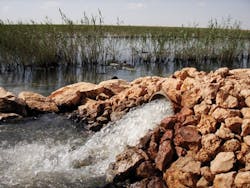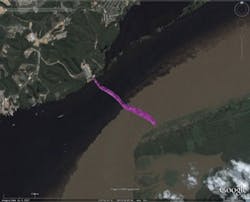Acoustic Doppler Flow Monitoring System Tackles the World's Largest River
By Andrew Walker
The Amazon River is a system so massive it nearly defies description. Draining a watershed bigger than Western Europe, the Amazon carries 52.2 million gallons per second to the Atlantic. That's 209,000 cubic meters per second. It's 7.38 million cfs. Nearly 16 times the average discharge of the Mississippi River. Enough to fill Lake Erie in less than a month. More fresh water flow than anywhere on earth.
To a hydrologist, every aspect of measuring the Amazon is a challenge of the highest magnitude.
"Everything is big," says SonTek Application Specialist David Velasco. "Everything is far away. Everything takes longer. And there's no Radio Shack on the margin you can run to."
It's not just the fact that the Amazon carries 15 percent of the world's fresh water that makes it so challenging to analyze. There are logistics to consider. There are no bridges spanning the river to provide a stable platform for instruments. It's hard to cross: a current of more than 3.5 meters per second (11.5 fps) sweeps small boats off track and challenges the skills and nerve of the pilots of larger craft. It's even hard to hold still as the current drags anchors across the muddy bottom.
There's also the challenging bathymetry of the system. A single crossing can pass over a flat, level bottom in one area and mega-ripples in another. Broad shallows give way to channels that plunge 100 meters (330 feet) deep. The muddy bottom is in nearly constant motion – which hydrologists call a "moving bed" – creating enormous challenges for accurately measuring velocity and properly positioning vessels at a known location.
The Mission: Testing and Training
And if that isn't enough, the summer of 2009 represented a 100-year flood in the Amazon Basin. On July 5, 2009, floodwaters peaked about six inches (15 cm) above the previous high-water mark established in 1953. A week later, Velasco and a SonTek team arrived in Brazil on a 10-day mission to put the RiverSurveyor M9 acoustic Doppler profiler to the ultimate test and participate in a national training session to train a new generation of Brazilian hydrologists on the M9's technology.
Amazon experts in Brazil were familiar with acoustic Doppler technology, which they have used to study flood events in the Amazon and other large rivers. They also provided invaluable feedback on the new RiverSurveyor system, and have been maintaining an ongoing dialogue with YSI on the instruments.
Brazil's hydrologists – a network of state, academic and regional specialists whose efforts are coordinated by the Agência Nacional de Águas (ANA), the national water agency – have a daunting task. Much depends on the success of their measurements – not just scientific knowledge on one of the world's great river systems, but also the establishment of hydrological budgets and resource management tools, the operation of the region's hydroelectric power grid, and the safety of villages and cities downstream during floods.
SonTek has proven the RiverSurveyor M9 on rivers around the world, large and small. But the Amazon was sure to push the technology to the limit.
Paulo Gamaro is hydrologist for Itaipu Binacional, which produced 94.7 million megawatt hours of electricity in 2008, securing its position as the world's largest-producing hydroelectric plant. Itaipu Binacional supplies 25% of Brazil's electricity and 75% of the electricity that powers neighboring Paraguay.
"Discharges are very important to us," Gamaro said. "We have to know accurate inflow to the dam. We do not have big capacity to store water – what goes in comes out, and we have very severe restrictions downstream."
Discharge data – the volume of water flowing past a fixed point in a river over a given time – helps Gamaro and his team set daily energy production forecasts and determine how to operate the plant to produce electricity while keeping water flowing in a manner that is safe for residents downstream. Where hydroelectric dams supply most of the nations' energy needs, that's no routine task.
Rising to the Challenge
Brazil's Amazon hydrologists have long risen to the challenges posed by the river. Pilots of the region's traditional 28-meter (92-foot), two-tiered riverboats have mastered the art of maintaining their course with sextant readings or keeping a stationary target on the deck lined up with tower-mounted theodolites near the far bank, allowing teams to take transect measurements with impellers and lead lines or older Doppler systems.
"It takes an experienced driver to do that," Velasco said. "They've gotten amazingly good at crossing the river.
"A lot of the challenge in taking readings in the Amazon is not about the measurement of velocity, but about knowing exactly where the boat is," he added. "That's not an easy task to do."
It also takes remarkable dedication, he said.
"A 10-person crew could take at least 12 hours to do one measurement at each location, and often longer," Velasco said. "There are 30 locations along the transect and at least two depths at each location, so that's at least 60 measurements of velocity."
Plug and Play
The effort required to employ older technology on the Amazon meant the first difference between the local standards and the RiverSurveyor M9 were evident minutes after setup began.
The SonTek team mounted the RiverSurveyor M9 on the gunwale of the boat, used a single cable to connect a GPS receiver and Power and Communications Module (PCM) on the upper deck, and set up a real-time kinematic (RTK) GPS correction station on the bank of the river to provide accuracy to within ±3 centimeters of the vessel's position. Once a secure mount was fabricated for the surveyor, daily setup took just 30 minutes – from opening up the box to being ready to make a measurement.
"The new RiverSurveyor system is as plug-and-play as you can get," Velasco said. "We designed it from the ground up to be integrated. All the handshaking and protocols were taken into consideration during design. So was simplifying the hardware. There's a GPS antenna with a built-in radio and one battery pack. There's just one cable between the PCM and the antenna on the roof, and just one button to power it on. There's Bluetooth to connect the radio back to the monitors. There's one button on the RTK base station. You power it on, and you power it off. That's it."
Plug-and-play simplicity stood in marked contrast to the hours required to coordinate separate components of the other system. Cabling, handshaking and communications protocols on the mixed-technology system each posed challenges.
Fabricio Vieira Alves, Executive Manager and Water Resources Specialist for ANA's Hydrometeorological Network Planning Office, points out that the RiverSurveyor M9 was designed specifically for river applications.
"This technological concept is quite different than the other manufacturers, who have taken devices originally designed for oceanographic application and adapted them to freshwater-based applications through the creation of different operational modes," he said.
Vieira sees pivotal roles for RiverSurveyors in Brazil's quarterly data collections and its long-term management of its rivers.
"The use of acoustic devices will allow us to significantly change our quarterly field campaigns, which will then allow us to cut operational costs and consequently expand the number of active stations," he said. "We also plan to use the system's acoustic intensity signal to determine suspended sediment concentration. And ANA is working to promote its use in other strategic regions, such as the Brazilian Northeast, where we need great accuracy for flow measurement in support of regulatory limits for minimum discharge."
Multiple Beams
The RiverSurveyor M9 uses nine transducers and multiple frequencies to deliver accurate data across a variety of conditions, automatically switching between frequencies to provide the optimum resolution for the channel depth.
Lower-frequency (1.0 MHz) beams provide bigger cells that capture velocity data deep in the river, Velasco said. The higher-frequency range (3.0 MHz) delivers smaller cells for measurement in shallower water. A vertical echosounder – the first time one has ever been integrated into a discharge system – guides the automatic frequency selection while delivering accurate depth readings and minimizing error from incorrect depth measurements.
In addition to demonstrating its ease of use, the M9 performed beyond expectations in depth, velocity and discharge measurements, Velasco said.
"Our brochure says we can profile to 30 meters with the 1 MHz beams, but we were actually profiling water in excess of 50 meters deep," he said. "We measured velocity in about 80 percent of the river, which is very acceptable, even in smaller systems. The vertical echosounder beam delivers bathymetry data to 80 meters, so we still got excellent volume data for estimating discharge on the remaining 20 percent. If we can measure there, we can tackle just about any flood nature can throw at us.
"The fact that the same instrument can also provide accurate data in a one-cubic-meter canal is also pretty amazing," he said.
Ultimately, the data proved to be extremely accurate in four widely diverse sites along the Amazon, on transects ranging from 700 meters (2,300 feet) to more than 5 km (3 miles) across – variations between back-to-back transects was generally under 0.2%, and peaked at only 1.2%.
MEETING OF THE WATERSBeyond the sheer enormity of the Amazon River system, the remarkable conditions at the confluence of the Rio Negro and the Solimões Rivers near the city of Manaus provided the opportunity for a team from SonTek to put the company's new RiverSurveyor M9 through a unique trial.
The Solimões – the upper branch of the Amazon – and the Negro meet at a nearly 90-degree angle to create a channel 2 kilometers (1.2 miles) across. Water in the Rio Negro, which drains broad plains, is black from decaying organic matter and remarkably free of sediment. The Solimões, by contrast, runs silty and brown with sediment from its mostly mountain path. Satellite imagery shows a clear boundary between the waters from the two rivers for nearly 60 kilometers (37 miles) before slow churning finally unites them completely.
"Conditions like this don't exist anywhere else on earth," said David Velasco, the SonTek Application Specialist who led the team. The result allowed Velasco and his colleagues to create what amounts to a side-by-side test of the M9 in a pair of thoroughly different conditions – along a single transect.
Sounding the Rio Negro with the RiverSurveyor M9's four 1 MHz beams, the team profiled to a depth of about 30 meters, a very respectable performance for the conditions. But the Solimões allowed the M9 to really demonstrate its capabilities.
"Scattering conditions in the Solimões are about as perfect as you can get," Velasco said. "There's just the right amount of sediment and the water's warm."
In fact, the RiverSurveyor transects at the Meeting of the Waters delivered important insight on the dynamics of the mixing zone, documenting underwater mixing that is occurring about 500 meters before such activity is apparent on the surface.
In the Solimões, the M9 delivered outstanding velocity readings to depths of 50 meters and more, Velasco said.
"We knew we would be pushing the limits of the M9's specified 30-meter maximum velocity profiling range," he said. "Now, our problem is that we'll need to update our brochures, because we're sure getting more than 30 meters!"
More Water & WasteWater International Current Issue Articles
More Water & WasteWater International Archives Issue Articles



